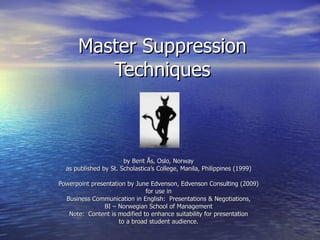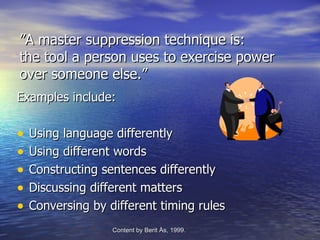Master Suppression Techniques
- 1. Master Suppression Techniques by Berit Ås, Oslo, Norway as published by St. Scholastica’s College, Manila, Philippines (1999) Powerpoint presentation by June Edvenson, Edvenson Consulting (2009) for use in Business Communication in English: Presentations & Negotiations, BI – Norwegian School of Management Note: Content is modified to enhance suitability for presentation to a broad student audience.
- 2. ”A master suppression technique is: the tool a person uses to exercise power over someone else.” Examples include: • Using language differently • Using different words • Constructing sentences differently • Discussing different matters • Conversing by different timing rules Content by Berit Ås, 1999. -Edvenson Consulting, 2009.
- 3. Some examples of cultural aspects Party A Party B • Influential • Subject to influence • Earning more money • Earning less money • Actively involved • Passively involved • Time managers • Time slaves • Planners • Followers • Dominant doers • Supportive doers • Ensuring power position • Unable to assure power position Content by Berit Ås, 1999. -Edvenson Consulting, 2009.
- 4. Technique number 1: Making Invisible • Occurs when a person (or group) chooses to treat an individual (or group) as if they were not there. • Examples: – A person presents and no one comments. – A person comments and no one responds. – A group/person raise their hands, but the instructor never calls on them. – A company presents an offer the other party pretends they did not hear or receive. – Paraverbal behavior that signals invisibility of others Content by Berit Ås, 1999. -Edvenson Consulting, 2009.
- 5. Effect of Making Another Invisible: • Robs individuals and groups of their identity. • Engenders feelings of inferiority and insignificance. • Encourages passive acceptance of prejudice . • Results in institutional rigidity. • Contributes to conformity – ’go-along to get- along.’ Content by Berit Ås, 1999. -Edvenson Consulting, 2009.
- 6. Technique number 2: Ridiculing • Occurs when one’s efforts are scorned, made fun of, presented as over-emotional or inappropriate. Can also occur when another is rejected as cold, manipulative, incompetent. • Examples: – A person tells others that his partner is sloppy when both share the responsibility for an error. – A boss suggests his employees are naive or stupid. – Advertisers use pornography that ridicules a specific type of person or group in order to sell their products. Content by Berit Ås, 1999. -Edvenson Consulting, 2009.
- 7. Effects of Ridiculing Others: • Embarrassment • Laughter • Insecurity • Satisfaction • Anger • Domination • Boredom • Control • Waning interest • Lack of self-esteem Content by Berit Ås, 1999. -Edvenson Consulting, 2009.
- 8. Technique number 3: Withholding Information • Occurs when one automatically takes up matters only with those of a select group. Involves preventing others from participating in comment and decisionmaking. • Examples: – A person gets agreements from a company Board by not sharing the information with specific interested parties. – A group meets socially, but conducts business affecting another related group or individual. Content by Berit Ås, 1999. -Edvenson Consulting, 2009.
- 9. Effect of Withholding Information: • Hurts information sharing for all – gaps in our knowledge • Encourages ’anti-social’ socializing • Fosters discrimination on illegal bases • Results in competent persons feeling ignorant, insecure & dis-connected Content by Berit Ås, 1999. -Edvenson Consulting, 2009.
- 10. Technique number 4: the ’Can’t-Win’ approach • ”Damned if you do, and damned if you don’t.” • Occurs when it is wrong one does something and also wrong not to choose the same thing. Involves being squeezed and pressured between mutually exclusive choices. • Examples: – A person wants to make the family happy, and commits to an activity. Their job then requires they commit to another activity that conflicts with the family’s plans. – A manager is accused of being weak when cooperative, yet also bullish when assertive. Content by Berit Ås, 1999. -Edvenson Consulting, 2009.
- 11. Effects of the ’Can’t Win’ Approach: • Discourages developing various interests, concerns, attachments • Results in constant guilty conscience • Creates stress from criticism -from both sides • Results in competent persons feeling ignorant, insecure & dis-connected • Feelings of inadequacy, loss & burn-out Content by Berit Ås, 1999. -Edvenson Consulting, 2009.
- 12. Technique number 5: Heap Blame & Put to Shame • Occurs when one is made to feel ’not good enough,’ even when that is due to (1) different behaviors, class, group, or (2) lack of access to information controlled by others. • Examples: – Encourages those ridiculed to ’accept’ their lowered status by shaming them directly or in front of others. – Suggests that signs of participatory behavior are inappropriate while cutting off possible avenues for participation. Content by Berit Ås, 1999. -Edvenson Consulting, 2009.
- 13. Effects of the Blame and Shame Approach: • Discourages assessing the actual or real source of problems and concerns • Prevents smart resolutions of real concerns • Brands victims for things they did not do • Encourages victims to accept blame • Results in competent persons feeling ignorant, insecure & worthless Content by Berit Ås, 1999. -Edvenson Consulting, 2009.
- 14. What can you do to avoid these? • Refuse to be complicit in domination actions. • Recognize others fairly and equitably. • Request respect and time for your participation. • Encourage others to recognize illogical and inefficient ’psychological warfare’ tactics. • Try to engage consistently in positive ways. The End Content by Berit Ås, 1999. -Edvenson Consulting, 2009.













